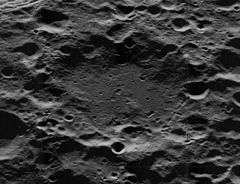H. G. Wells (crater)
|
Oblique Lunar Orbiter 5 image, facing west | |
| Coordinates | 40°42′N 122°48′E / 40.7°N 122.8°ECoordinates: 40°42′N 122°48′E / 40.7°N 122.8°E |
|---|---|
| Diameter | 114 km |
| Depth | Unknown |
| Colongitude | 239° at sunrise |
| Eponym | H. G. Wells |


H. G. Wells is a lunar crater that is located on the far side of the Moon, behind the northeastern limb. It lies to the south of the crater Millikan, and to the northeast of Cantor. Just to the southeast is the smaller Tesla.
This large formation is most notable for the extremely battered state of its outer rim. Little or nothing remains of the original rim, so completely has it been eroded and incised by smaller craters. As a result, the crater floor is now surrounded by a ring of irregular peaks and worn crater valleys. This rugged surroundings intrudes only part way into the interior, while the remaining floor is relatively level and in some places gently rolling. The interior is marked only by a multitude of tiny craterlets.
The writer H. G. Wells won the right to have a Moon crater named after him by his well-known science fiction novel "The First Men in the Moon".
Satellite craters
By convention these features are identified on lunar maps by placing the letter on the side of the crater midpoint that is closest to H. G. Wells.
| H. G. Wells | Latitude | Longitude | Diameter |
|---|---|---|---|
| X | 40.70° N | 122.80° E | 114 km |
References
- Andersson, L. E.; Whitaker, E. A. (1982). NASA Catalogue of Lunar Nomenclature. NASA RP-1097.
- Blue, Jennifer (July 25, 2007). "Gazetteer of Planetary Nomenclature". USGS. Retrieved 2007-08-05.
- Bussey, B.; Spudis, P. (2004). The Clementine Atlas of the Moon. New York: Cambridge University Press. ISBN 978-0-521-81528-4.
- Cocks, Elijah E.; Cocks, Josiah C. (1995). Who's Who on the Moon: A Biographical Dictionary of Lunar Nomenclature. Tudor Publishers. ISBN 978-0-936389-27-1.
- McDowell, Jonathan (July 15, 2007). "Lunar Nomenclature". Jonathan's Space Report. Retrieved 2007-10-24.
- Menzel, D. H.; Minnaert, M.; Levin, B.; Dollfus, A.; Bell, B. (1971). "Report on Lunar Nomenclature by the Working Group of Commission 17 of the IAU". Space Science Reviews. 12 (2): 136–186. Bibcode:1971SSRv...12..136M. doi:10.1007/BF00171763.
- Moore, Patrick (2001). On the Moon. Sterling Publishing Co. ISBN 978-0-304-35469-6.
- Price, Fred W. (1988). The Moon Observer's Handbook. Cambridge University Press. ISBN 978-0-521-33500-3.
- Rükl, Antonín (1990). Atlas of the Moon. Kalmbach Books. ISBN 978-0-913135-17-4.
- Webb, Rev. T. W. (1962). Celestial Objects for Common Telescopes (6th revised ed.). Dover. ISBN 978-0-486-20917-3.
- Whitaker, Ewen A. (1999). Mapping and Naming the Moon. Cambridge University Press. ISBN 978-0-521-62248-6.
- Wlasuk, Peter T. (2000). Observing the Moon. Springer. ISBN 978-1-85233-193-1.
